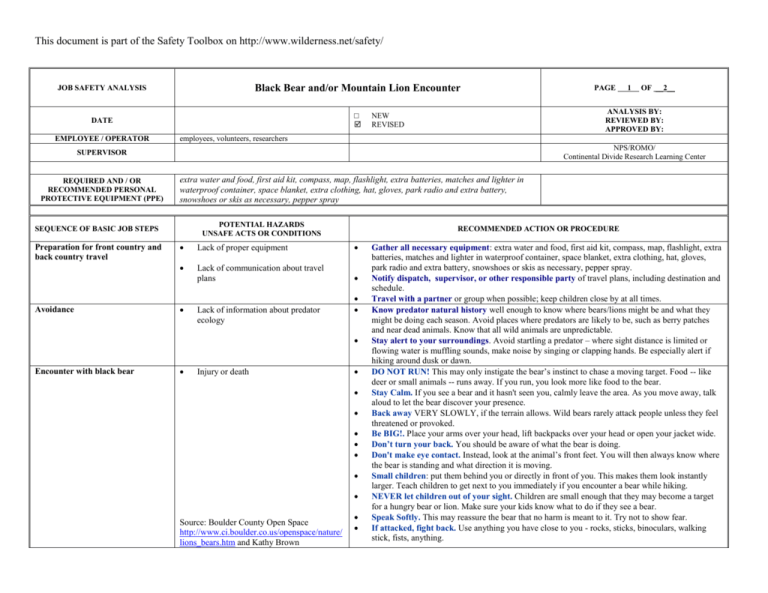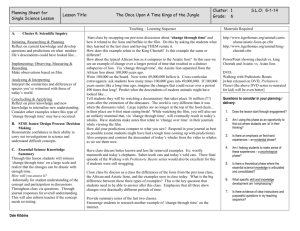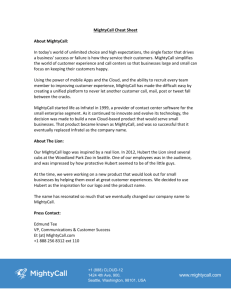Bear, Mountain Lion Encounter
advertisement

This document is part of the Safety Toolbox on http://www.wilderness.net/safety/ JOB SAFETY ANALYSIS Black Bear and/or Mountain Lion Encounter DATE □ EMPLOYEE / OPERATOR Avoidance NPS/ROMO/ Continental Divide Research Learning Center extra water and food, first aid kit, compass, map, flashlight, extra batteries, matches and lighter in waterproof container, space blanket, extra clothing, hat, gloves, park radio and extra battery, snowshoes or skis as necessary, pepper spray POTENTIAL HAZARDS UNSAFE ACTS OR CONDITIONS RECOMMENDED ACTION OR PROCEDURE Lack of proper equipment Lack of communication about travel plans Lack of information about predator ecology Encounter with black bear OF __2__ employees, volunteers, researchers SEQUENCE OF BASIC JOB STEPS Preparation for front country and back country travel 1 ANALYSIS BY: REVIEWED BY: APPROVED BY: NEW REVISED SUPERVISOR REQUIRED AND / OR RECOMMENDED PERSONAL PROTECTIVE EQUIPMENT (PPE) PAGE Injury or death Source: Boulder County Open Space http://www.ci.boulder.co.us/openspace/nature/ lions_bears.htm and Kathy Brown Gather all necessary equipment: extra water and food, first aid kit, compass, map, flashlight, extra batteries, matches and lighter in waterproof container, space blanket, extra clothing, hat, gloves, park radio and extra battery, snowshoes or skis as necessary, pepper spray. Notify dispatch, supervisor, or other responsible party of travel plans, including destination and schedule. Travel with a partner or group when possible; keep children close by at all times. Know predator natural history well enough to know where bears/lions might be and what they might be doing each season. Avoid places where predators are likely to be, such as berry patches and near dead animals. Know that all wild animals are unpredictable. Stay alert to your surroundings. Avoid startling a predator – where sight distance is limited or flowing water is muffling sounds, make noise by singing or clapping hands. Be especially alert if hiking around dusk or dawn. DO NOT RUN! This may only instigate the bear’s instinct to chase a moving target. Food -- like deer or small animals -- runs away. If you run, you look more like food to the bear. Stay Calm. If you see a bear and it hasn't seen you, calmly leave the area. As you move away, talk aloud to let the bear discover your presence. Back away VERY SLOWLY, if the terrain allows. Wild bears rarely attack people unless they feel threatened or provoked. Be BIG!. Place your arms over your head, lift backpacks over your head or open your jacket wide. Don’t turn your back. You should be aware of what the bear is doing. Don't make eye contact. Instead, look at the animal’s front feet. You will then always know where the bear is standing and what direction it is moving. Small children: put them behind you or directly in front of you. This makes them look instantly larger. Teach children to get next to you immediately if you encounter a bear while hiking. NEVER let children out of your sight. Children are small enough that they may become a target for a hungry bear or lion. Make sure your kids know what to do if they see a bear. Speak Softly. This may reassure the bear that no harm is meant to it. Try not to show fear. If attacked, fight back. Use anything you have close to you - rocks, sticks, binoculars, walking stick, fists, anything. Encounter with mountain lion Injury or death Every situation is different with respect to the mountain lion, the terrain, the people and their activity. Source: Boulder County Open Space http://www.ci.boulder.co.us/openspace/nature/ lions_bears.htm Leaving the scene/post encounter reporting Visitor reports of kill sites or aggressive animals Possibility of further danger from animal if not reported Injury to visitors or employees DO NOT RUN! This may only instigate the lion’s instinct to chase a moving target. Food -- like deer or small animals -- runs away. If you run, you look more like food to the mountain lion. Give the lion some room. If the lion sees you, give it room to escape. In nearly ALL cases, the lion will try to get away from you. This also works as time for you to calm down and think clearly. Don’t assume there is only one lion. Look around carefully. Although usually solitary, they have been known to travel together, especially younger lions. Be BIG! Place your arms over your head, lift backpacks over your head or open your jacket wide. Small children: put them behind you or directly in front of you. This makes them look instantly larger. Teach children to get next to you immediately if you encounter a lion while hiking. NEVER let children out of your sight. Children are small enough that they may become a target for a hungry lion. Make sure your kids know what to do if they see a lion. Talk to the lion softly. Back away VERY SLOWLY, if the terrain allows. Don’t turn your back. You should be aware of what it is doing. Don't make eye contact. Instead, look at the animal’s front feet. You will then always know where the lion is standing and what direction it is moving. If attacked, fight back. Use anything you have close to you - rocks, sticks, binoculars, walking stick, fists, anything. Contact dispatch and fill out wildlife form/card to report an encounter with bear and mountain lion signs, or aggressive behavior from wildlife. Law enforcement will post education/warning signs. In cases of animals approaching humans; animal may be destroyed to prevent attack. Report incident to dispatch with as much information as possible. Keep reporting party with you until dispatch or LE clears. Explain to reporting party why it is important for them to stay with you. Fill out appropriate NPS forms.








